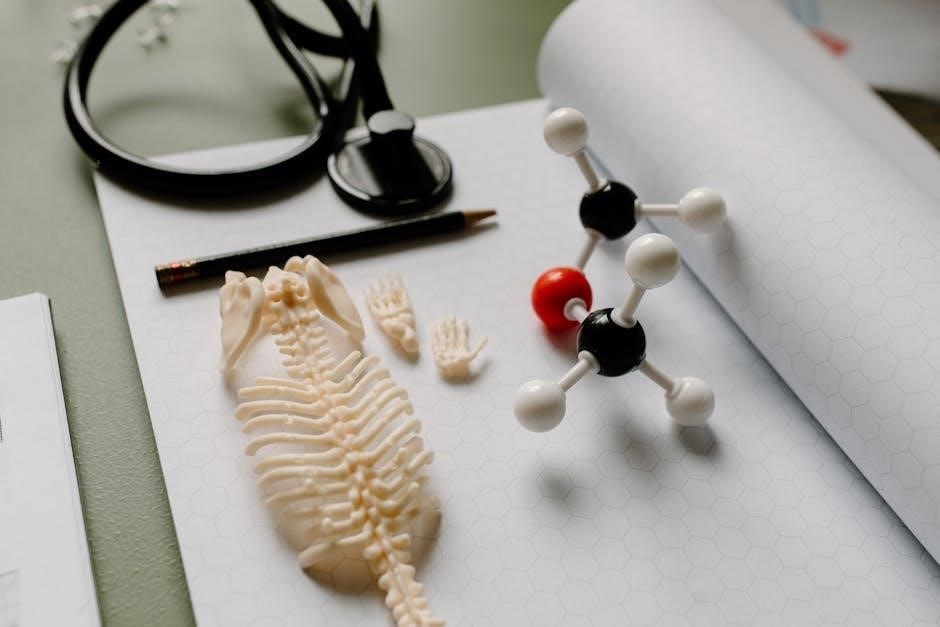
The AP Chemistry Textbook PDF is a valuable resource for students preparing for the exam‚ offering a comprehensive review‚ practice exams‚ and essential study strategies.
Overview of the AP Chemistry Exam
The AP Chemistry exam is a rigorous‚ college-level assessment administered annually to high school students. It evaluates understanding of fundamental chemistry concepts‚ including atomic structure‚ chemical bonding‚ thermodynamics‚ and kinetics. The exam consists of two sections: multiple-choice questions and free-response problems. Students’ performance determines eligibility for college credit‚ with successful scores potentially granting advanced placement. The exam is graded by experienced educators and professors‚ ensuring consistency and accuracy. Preparation is crucial‚ as the test covers a wide range of topics‚ from stoichiometry to redox reactions. The AP Chemistry Textbook PDF serves as an essential tool‚ providing comprehensive review materials and practice exams to help students achieve success.
Importance of Using a Textbook for Preparation
A textbook is a cornerstone of effective AP Chemistry preparation‚ offering a structured and comprehensive approach to mastering the subject. It provides in-depth explanations of complex concepts‚ such as atomic structure‚ chemical bonding‚ and thermodynamics‚ ensuring a solid foundation for understanding. The organized content helps students navigate topics systematically‚ while practice exams and diagnostic tests allow for self-assessment and improvement. Additionally‚ textbooks often include test-taking strategies and tips‚ which are invaluable for optimizing performance on exam day. By using a textbook‚ students can identify weaknesses‚ reinforce strengths‚ and develop a confident command of chemistry principles‚ ultimately enhancing their readiness for the AP exam.
Benefits of a PDF Format for Studying
The PDF format offers numerous advantages for studying‚ particularly for AP Chemistry preparation. It provides easy access to study materials anytime‚ anywhere‚ without the need for physical books. PDFs are highly portable‚ allowing students to carry an entire textbook on their digital devices‚ making it ideal for on-the-go learning. The format also supports keyword searches‚ enabling quick navigation to specific topics like chemical bonding or thermodynamics. Additionally‚ PDFs can be easily annotated and highlighted‚ facilitating active learning and note-taking. The ability to zoom in on complex diagrams and equations ensures clarity‚ while hyperlinks to additional resources enhance the study experience. Overall‚ the PDF format combines convenience‚ flexibility‚ and functionality‚ making it an essential tool for efficient AP Chemistry preparation.

Key Features of the AP Chemistry Textbook PDF

The PDF includes a comprehensive subject review‚ practice exams‚ test-taking strategies‚ and detailed explanations‚ aligning with the AP Chemistry exam format for effective preparation.
Comprehensive Subject Review
The AP Chemistry Textbook PDF provides a detailed and organized review of all essential topics‚ ensuring a thorough understanding of chemistry concepts. It covers the structure of matter‚ atomic structure‚ chemical bonding‚ and the periodic table‚ offering clear explanations and examples. The review extends to states of matter‚ physical chemistry‚ chemical reactions‚ and stoichiometry‚ with a focus on thermodynamics and kinetics. Equilibria‚ acid-base reactions‚ and redox reactions are also thoroughly addressed‚ along with an introduction to organic chemistry basics. This comprehensive approach aligns with the AP Chemistry exam format‚ helping students build a strong foundation and prepare confidently for the test. The PDF ensures that all key areas are explored in depth‚ making it an invaluable study resource.
Practice Exams and Diagnostic Tests
The AP Chemistry Textbook PDF includes six practice exams‚ comprising three diagnostic tests and three full-length practice exams‚ all aligned with the updated AP Chemistry exam format. These resources provide students with the opportunity to assess their knowledge and identify areas for improvement. Each question is accompanied by detailed explanations‚ ensuring a deeper understanding of concepts. The diagnostic tests help pinpoint strengths and weaknesses‚ while the full-length exams simulate real test conditions‚ allowing students to practice time management and strategy. By utilizing these practice exams‚ students can familiarize themselves with the exam structure and content‚ building confidence and readiness for the actual AP Chemistry exam; Regular use of these tests is a proven way to enhance performance and achieve success.
Test-Taking Strategies and Tips

The AP Chemistry Textbook PDF provides essential test-taking strategies to help students maximize their scores. Tips include understanding the exam format‚ managing time effectively‚ and reviewing common mistakes. Emphasizing the importance of reading questions carefully and eliminating incorrect answers before selecting a response is highlighted. Strategies for tackling free-response questions‚ such as organizing thoughts and using proper scientific terminology‚ are also covered. Additionally‚ the guide encourages practicing under timed conditions to build stamina and reduce anxiety. By mastering these strategies‚ students can approach the exam with confidence and improve their overall performance. These tips are designed to complement the textbook’s content‚ ensuring a well-rounded preparation for the AP Chemistry exam.

Content Outline of the AP Chemistry Textbook
The textbook covers key topics like atomic structure‚ chemical bonding‚ states of matter‚ thermodynamics‚ kinetics‚ equilibria‚ acid-base reactions‚ redox reactions‚ and organic chemistry basics.

Structure of Matter and Atomic Structure
The section on Structure of Matter and Atomic Structure provides a foundational understanding of chemistry‚ starting with the basics of matter and delving into atomic composition. It explores atomic structure‚ including electron configuration‚ quantum numbers‚ and periodic trends‚ which are crucial for understanding chemical behavior. The material also covers the periodic table‚ emphasizing how elements are organized and how their properties relate to their atomic structure. This section is essential for building a strong grasp of chemistry principles‚ as it connects the microscopic properties of atoms to the macroscopic behavior of matter. Clear explanations and examples are provided to help students master these fundamental concepts‚ which are central to success in AP Chemistry.
Chemical Bonding and Periodic Table
The section on Chemical Bonding and Periodic Table dives into the fundamental principles of how atoms interact and form compounds. It explores the different types of chemical bonds‚ including ionic‚ covalent‚ and metallic bonding‚ and explains the factors influencing bond formation. The periodic table is thoroughly examined‚ highlighting periodic trends such as atomic radius‚ electronegativity‚ and ionization energy. These trends are linked to the chemical properties of elements‚ enabling students to predict and understand chemical behavior. The material also discusses molecular geometry and bonding theories‚ providing a solid foundation for analyzing chemical reactions and interactions. This section is crucial for mastering the core concepts of chemistry and applying them to solve complex problems in the AP exam.
States of Matter and Physical Chemistry
The section on States of Matter and Physical Chemistry provides an in-depth exploration of the properties and behaviors of solids‚ liquids‚ and gases. It delves into the kinetic molecular theory‚ phase changes‚ and the factors influencing these transitions‚ such as temperature and pressure. The material also covers gas laws‚ including Boyle’s‚ Charles’s‚ and the ideal gas law‚ which are essential for understanding the behavior of gases. Additionally‚ the section examines the principles of thermodynamics‚ including internal energy‚ enthalpy‚ and entropy‚ which are fundamental to physical chemistry. This chapter equips students with the knowledge to analyze and solve problems related to the physical properties of matter and their role in chemical systems‚ making it a cornerstone of AP Chemistry preparation.
Chemical Reactions and Stoichiometry
The section on Chemical Reactions and Stoichiometry is a cornerstone of the AP Chemistry Textbook PDF‚ providing a detailed exploration of chemical equations‚ reaction types‚ and stoichiometric calculations. Students learn to balance chemical equations‚ determine limiting reagents‚ and calculate theoretical and percent yields. The material emphasizes the importance of stoichiometry in quantifying chemical processes‚ from simple reactions to complex systems. Practical examples and practice problems are included to reinforce understanding‚ ensuring students can apply these concepts to real-world scenarios. This chapter is essential for mastering the quantitative aspects of chemistry‚ a critical skill for success on the AP exam and in advanced chemistry studies.
Thermodynamics and Kinetics
The Thermodynamics and Kinetics section of the AP Chemistry Textbook PDF delves into the fundamental principles governing energy changes and reaction rates. Students explore the laws of thermodynamics‚ including internal energy‚ enthalpy‚ and entropy‚ to understand whether reactions are spontaneous. The textbook also examines kinetics‚ focusing on reaction rates‚ rate laws‚ and the factors influencing them‚ such as concentration‚ temperature‚ and catalysts. Detailed explanations and practice problems help students master these concepts‚ which are critical for analyzing chemical processes. The section emphasizes the interplay between thermodynamics and kinetics‚ enabling students to predict reaction outcomes and optimize conditions. This knowledge is essential for tackling complex questions on the AP exam and applying it to real-world chemical systems.
Equilibria and Acid-Base Reactions
The Equilibria and Acid-Base Reactions section in the AP Chemistry Textbook PDF provides a thorough exploration of chemical equilibrium principles and acid-base chemistry. Students learn to analyze equilibrium systems using Le Chatelier’s principle and K expressions‚ as well as understand the behavior of strong and weak acids and bases. The textbook covers acid-base theories‚ including Arrhenius‚ Bronsted-Lowry‚ and Lewis definitions‚ and explains how to calculate pH‚ pOH‚ and buffer solutions. Practice problems and real-world applications help reinforce these concepts‚ which are crucial for solving equilibrium and acid-base problems on the AP exam. This section ensures students master the foundational knowledge needed for advanced chemical analysis and problem-solving.
Redox Reactions and Organic Chemistry Basics
The Redox Reactions and Organic Chemistry Basics section in the AP Chemistry Textbook PDF delves into the fundamentals of oxidation-reduction reactions and introductory organic chemistry. Students explore how to identify oxidation states‚ balance redox equations‚ and understand electron transfer processes. The organic chemistry portion introduces nomenclature‚ isomerism‚ and basic reaction mechanisms‚ providing a solid foundation for understanding hydrocarbons and functional groups; Practice problems and examples help students master these concepts‚ which are essential for solving complex chemical equations and understanding molecular structures. This section bridges the gap between inorganic and organic chemistry‚ preparing students for advanced topics in the AP curriculum.

How to Use the AP Chemistry Textbook Effectively
Maximize your preparation with the AP Chemistry Textbook PDF by utilizing its comprehensive subject review‚ practice exams‚ and test-taking strategies to master concepts and excel on the exam.
Creating a Study Schedule
A well-structured study schedule is essential for mastering the AP Chemistry material. Start by breaking down the textbook content into manageable sections‚ focusing on key topics like atomic structure‚ chemical bonding‚ and thermodynamics. Allocate specific days for reviewing concepts‚ practicing problems‚ and taking diagnostic tests. Dedicate time each week to analyze practice exam results‚ identifying weak areas that need more attention. Incorporate regular review sessions to reinforce previously learned material and ensure long-term retention. Balance study sessions with breaks to maintain productivity and avoid burnout. By following a consistent and organized plan‚ you can efficiently cover the entire curriculum and build confidence for the exam. Adjust the schedule as needed to accommodate your learning pace and goals.
Utilizing Practice Tests for Self-Assessment
Practice tests are a cornerstone of effective preparation for the AP Chemistry exam. They provide a realistic simulation of exam conditions‚ helping you assess your knowledge and identify areas needing improvement. Regularly taking practice tests allows you to track your progress over time and refine your understanding of key concepts. The tests included in the PDF are aligned with the actual exam format‚ ensuring familiarity with question types and timing. After each test‚ review your mistakes to understand where you went wrong and focus your study efforts accordingly. Consistent use of practice tests builds confidence and ensures readiness for the challenges of the actual exam. Make them a regular part of your study routine for optimal results.
Understanding and Applying Science Practices
Mastering science practices is essential for success in AP Chemistry‚ as they are integrated into both the content and the exam format. The textbook PDF emphasizes the development of these skills‚ such as experimental design‚ data analysis‚ and scientific reasoning. By engaging with these practices‚ students learn to approach problems systematically and think critically. The PDF provides examples and exercises that simulate real-world scientific scenarios‚ helping students apply concepts to practical situations. Regular practice with these skills builds proficiency and confidence‚ ensuring readiness for the exam’s free-response questions. Understanding and applying science practices not only enhances exam performance but also fosters a deeper appreciation of chemistry as a scientific discipline. This skill set is invaluable for future academic and professional pursuits in science.

Downloading and Accessing the PDF
The AP Chemistry Textbook PDF is readily available online‚ offering a straightforward download process. It is compatible with various digital devices‚ ensuring easy access for all users.
Free Resources and Download Links
Accessing the AP Chemistry Textbook PDF is straightforward‚ with numerous free resources and direct download links available online. These resources are designed to support students and educators‚ providing comprehensive study materials. The PDF is compatible with various digital devices‚ including smartphones‚ tablets‚ and laptops‚ ensuring flexibility in study routines. Many websites offer free downloads‚ making it easy to obtain the textbook without additional costs. These resources often include supplementary materials‚ such as practice exams and study guides‚ to enhance preparation for the AP Chemistry exam. By utilizing these free resources‚ students can efficiently access high-quality study content anytime‚ anywhere‚ helping them achieve their academic goals.
Compatibility with Digital Devices

The AP Chemistry Textbook PDF is designed to be compatible with a wide range of digital devices‚ ensuring accessibility and convenience for students. Whether you prefer studying on a smartphone‚ tablet‚ or laptop‚ the PDF format allows for seamless reading and navigation. Its lightweight design ensures quick loading and minimal storage requirements‚ making it easy to access on any device with a PDF viewer. This compatibility enables students to study anywhere‚ whether at home‚ in the classroom‚ or on the go. The PDF’s portability and adaptability make it an ideal resource for modern learners who rely on multiple devices for their academic preparation.
The AP Chemistry Textbook PDF is a comprehensive and accessible resource‚ offering detailed content‚ practice exams‚ and strategies to help students excel on the AP Chemistry exam.

Final Tips for Success on the AP Exam
To excel on the AP Chemistry exam‚ focus on consistent study habits and understanding core concepts. Utilize the PDF textbook’s practice tests to identify weak areas and improve; Pay attention to science practices‚ as they are central to the exam. Time management during the test is crucial—allocate time wisely for multiple-choice and free-response sections. Reviewing test-taking strategies provided in the PDF can enhance your performance. Regularly assess your progress and seek clarification on challenging topics. By combining thorough preparation with effective test strategies‚ you’ll be well-prepared to achieve a high score and potentially earn college credit.
Additional Resources for Supplemental Study
Beyond the AP Chemistry Textbook PDF‚ students can benefit from supplementary resources like online practice platforms‚ video tutorials‚ and interactive study guides. These tools provide additional practice problems‚ detailed explanations‚ and visual aids to reinforce complex concepts. Many websites offer free or low-cost resources‚ including diagnostic tests and study tips tailored for AP Chemistry. Utilizing these materials can help students identify and address gaps in their knowledge. Additionally‚ joining online study groups or forums can provide valuable peer support and collaborative learning opportunities. By combining the textbook with these resources‚ students can create a well-rounded study plan that enhances their understanding and confidence for the exam.